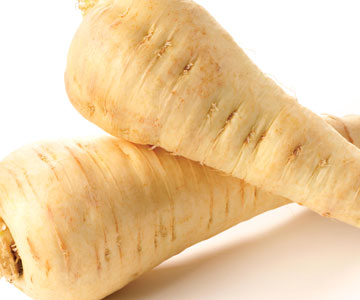
The parsnip (Pastinaca sativa) is a root vegetable related to the carrot. Parsnips resemble carrots, but are paler than most carrots and have a sweeter taste, especially when cooked. The buttery, slightly spicy, sweet flavor of cooked mature (often picked after the first frost) parsnips is reminiscent of butterscotch, honey, and subtle cardamom. Like carrots, parsnips are native to Eurasia and have been eaten there since ancient times. Zohary and Hopf note that the archeological evidence for the cultivation of the parsnip is “still rather limited,” and that Greek and Roman literary sources are a major source about its early use, but warn "there are some difficulties in distinguishing between parsnip and carrot (which, in Roman times, were white or purple) in classical writings since both vegetables seem to have been sometimes called pastinaca yet each vegetable appears to be well under cultivation in Roman times.
Health benefits of parsnips
Generally, parsnip contains more sugar than carrots, radish, turnips, and has calories (100 g provide 75 calories) equivalent to that of some fruits like banana, grapes…etc. Nonetheless, its sweet, juicy roots are rich in several health benefiting phyto-nutrients, vitamins, minerals, and fiber.
It is one of the excellent sources of soluble and insoluble dietary fiber. 100 g root provides 4.9 mg or 13% of fiber. Adequate fiber in the diet helps reduce blood cholesterol levels, obesity and constipation conditions.
Like in carrots other members of apiaceae family vegetables, parsnip too contains many poly-acetylene anti-oxidants such as falcarinol, falcarindiol, panaxydiol, and methyl-falcarindiol.
Several research studies from scientists at University of Newcastle at Tyne found that these compounds have anti-inflammatory, anti-fungal, and anti-cancer function and offer protection from colon cancer and acute lymphoblastic leukemia (ALL).
Fresh roots are also good in vitamin C; provide about 17 mg or 28% of RDA. Vitamin C is water soluble anti-oxidant. It helps body maintain healthy connective tissue, teeth, and gum. Its anti-oxidant property helps body protect from diseases and cancers by scavenging harmful free radicals.
Further, it is rich in many B-complex groups of vitamins such as folic acid, vitamin B-6 (pyridoxine), thiamin, and pantothenic acid as well as vitamin K and vitamin E.
In addition, it also has healthy levels of minerals like iron, calcium, copper, potassium, manganese and phosphorus. Potassium is an important component of cell and body fluids that helps controlling heart rate and blood pressure by countering effects of sodium.